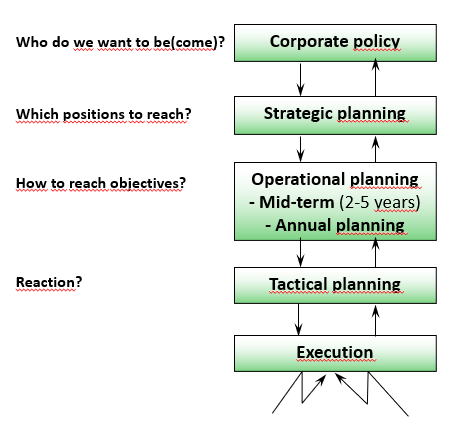Last Updated on March 12, 2024 by Lukas Rieder
The Main Questions of each Planning Stage
Before implementation of its operational plan, each company needs to distinguish between four planning levels (or management levels), as in each of these levels a different question needs to be addressed.

Corporate policy (or mission statement) defines what the organization plans to become in the future and how it will distinguish itself from others. A company must consider the requirements of the various environments in which it operates and, if necessary, react to changes in these requirements. These adjustments should be reflected in the core values of the owners and senior management to determine whether the whole business can become what it wants to be.
As noted in our book (Management Control with Integrated Planning), the basic corporate policy statements are documented in three corporate concepts: the performance-based concept, the financial concept, and the social concept. The performance-based concept should be in line with the technological and market environments. Elements of the financial concept are profitability to be achieved, financing structure, use of results, maintenance of liquidity. The social concept sets out the guidelines on topics such as management methods, employee development, and conduct towards government, associations and competitors.
Strategic planning defines which markets are to be served, with which products and services, which technologies appear to be decisive for implementation, and in which price segments one wants to offer. Additionally it is necessary to identify which existing internal potentials for success must be enhanced and which new ones must be built up in order to reach the wanted market positions.
In operational planning the results to be achieved are recorded in terms of content and deadlines. The question is therefore how and by when the targeted market positions are to be achieved. In operational medium-term planning (usually 2 – 5 years), the focus is on building up and expanding the success potentials required for strategy implementation. The planning contents are often structured according to functional areas, because the potentials have to be built up there (personnel, market development, suppliers, plants, IT, financing). To document these plans, it is advisable to define functional concepts. In this way, it can be tracked whether the development of potentials is progressing properly and on schedule.
In (operational) annual planning, the results (objectives) to be achieved in the planned year are derived from the strategies and the functional concepts and transferred to the sub-budgets. This makes it clear to everyone involved what contributions they should make to ensure that the organization as a whole achieves its goals. Finally, the content-related plans and objectives must also be represented in terms of value, so that it is clear whether the plans are financially feasible. This is done in the cost, activity, revenue and profit and loss account (via management accounting).
Because customers order products in different quantities and at different times than planned, because unexpected plant downtimes occur, and because employees can be absent or projects delayed, tactical planning and control during the year is necessary. The majority of the data required for planning is managed in the ERP (Enterprise Resource Planning) systems. The comparison of actual data with planning supports employees and managers in meeting their annual targets.
